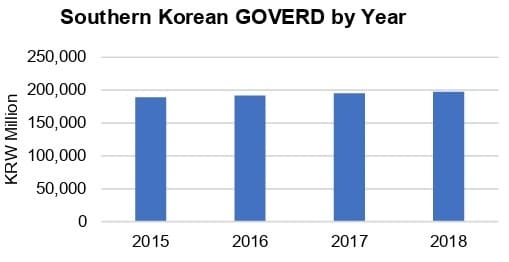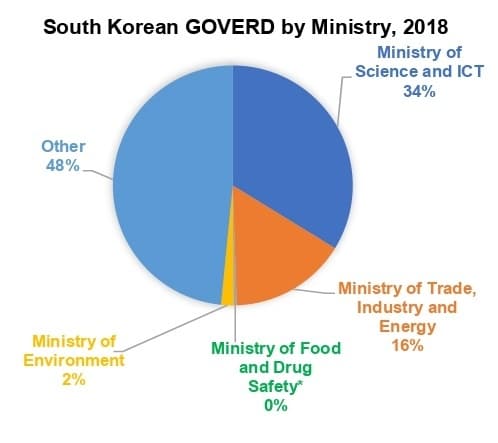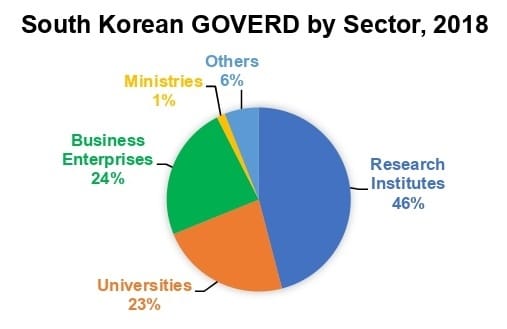South Korea’s 2018 Government R&D Outlays Rise Slightly but Biotech Industry Stays Formidable
South Korea is one of the world’s largest spenders on R&D worldwide in relation to GDP. The Organization for Economic Development & Cooperation’s (OECD) put the country’s gross domestic expenditure on R&D (percentage of GDP spent on R&D) at 4.55% in 2017 compared to 2.37% for OECD countries and other major economies, including China, according to the OECD Main Science and Technology Indicators Database published earlier this year.
Released this week, the latest volume of the “100 Main Science & Technology Indicators of Korea” from the Korea Institute of S&T Evaluation and Planning updates the government’s R&D figures for 2018, showing modest increases overall in government spending.

Source: Korea Institute of S&T Evaluation and Planning
Government
The latest publication provides figures for the South Korean government’s R&D spending in 2018. Total government budget appropriations or outlays for R&D (GOVERD) inched up 1.3% last year to KRW 197,483 million ($179.6 billion at KRW 1,099.39 = $1), compared to 1.8% and 1.4% growth in 2016 and 2017, respectively. Among the four ministries covered here (see pie chart below), which are most representative of scientific investments, the Ministry of Environment showed the largest jump in R&D budget last year, escalating 15.9%, while the Ministry of Food and Agriculture’s designated outlays rose a scant 1.1%.

*Percentage due to rounding
Source: Korea Institute of S&T Evaluation and Planning
In contrast, the Ministry of Science and ICT, and the Ministry of Trade, Industry and Energy’s GOVERD dropped 1.7% and 0.4%, respectively. A specific environmental goal that may have influenced the increase in outlays for environmental spending was air quality, according to UPI. In 2017, the government announced an effort to reduce air pollution as part of a five-year commitment. But in contrast to the Ministry’s budget, total GOVERD for environmental technologies fell 2.7% to KRW 22,294 million ($9.1 billion) in 2018.
Of the performance sectors funded by the South Korean government, research institutes represented the highest proportion of GOVERD last year, rising 2.1% to make up 45.9%. This percentage far surpassed universities’ 22.9% share. At 23.6%, business enterprises’ GOVERD was not far behind universities’ share. Among these three entities, universities recorded the fastest government budget increase with a 3.0% uptick. Business enterprises GOVERD developed at nearly the same pace, growing 2.9%, while research institutes recorded a 2.1% increase.
Most government funding for R&D in South Korea goes toward basic research, which accounted for 33% of GOVERD in 2018. Nonetheless, this was a decrease from the previous year when it made up 34%, in line with the year-over-year 2.7% drop in budget. Likewise, for development research, the share of government also declined on a percentage basis last year, sinking to 47.1% from 47.7%, with outlays declining 1.0%. However, the government budget for applied research was stronger last year, growing 5.5% go make up 20.2% of the total, compared to 19.1% in 2018.
Biotech
South Korea has established itself as a leader in biopharma R&D. KoreaBioMed reported earlier this year that the country’s drug companies pour 13% of annual sales into R&D. However, government support for biotech as measured by GOVERD rose only 1.6% in 2018 to reach KRW 35,494 million ($32.3 billion), down from 4.8% in the prior year.

Source: Korea Institute of S&T Evaluation and Planning
Nonetheless, the country’s biotech sector remains robust. In 2017, the latest year for which figures were available, the output for the biotech industry climbed 9.4% to KRW 10.13 trillion ($9.0 billion at KRW 1130.43 = $1)), while biotech exports jumped 11.2% to KRW 5.15 trillion ($4.6 billion). In keeping with this trend, in 2017, the number of R&D personnel employed by the country’s biotech sector grew 3.5% to 13,613, making up 46% of the biotech industry personnel, with the remainder classified as production personnel. Together, biotech R&D and production personnel comprised 6.2% of the country’s total R&D workforce in 2017.





